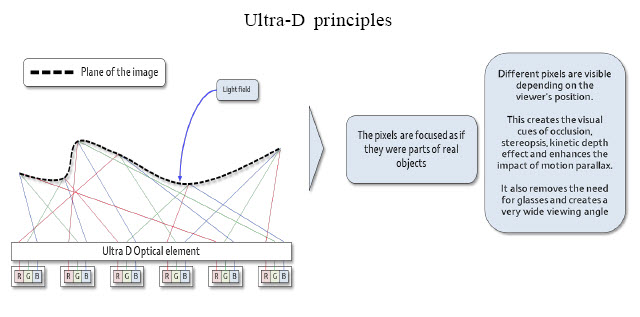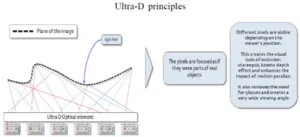
Walther Roelen is from SeeCubic, which is a subsidiary of streamTV and which he founded. He avoids the use of the term 3D, he said.
He looked at how computer models were developed to help architects and others to visualise designs. He showed how it is hard to perceive depths and scale if you don’t have the right lighting. 3D TV is not the same as stereo, he said, and if you doubt it, try lying down while watching stereo!
Roelen then looked at the factors that humans rely on for depth perception. His daughter had a problem with one eye, but can drive etc perfectly well, because of other depth cues, beyond stereopsis. Ultra-D supports these cues including very good impressions of depth from 2D images.
Stereoscopy provides a depth experience, but is not so good. W then went through how lenticulars work.
Ultra-D has a diffractive/refractive optical element which can create a pixel focused in front or behind the screen. There can be up to 256 z levels and it’s similar to a lightfield display.
 SeeCubic’s Ultra-D principle. Click for higher resolution
SeeCubic’s Ultra-D principle. Click for higher resolution
The 50″ and 65″ units are in production with Pegatron who are making 1000 per week in the 65″ size and the company is working with Panasonic and others. Roelen said that he hopes to get to around a million units in 2018. Plug ins are available for Adobe or other software to help to create depth maps, which form part of the StreamTV ecosystem.
Analyst Comment
I’ve been impressed with the quality of the 3D that StreamTV has been showing at shows. I wonder, though, about the re-positioning of lenticular displays as ‘lightfield’ displays. I guess they are and I can understand the desire to avoid the term 3D, and adopt something more trendy, but the danger is that newer lightfield displays are not given consideration because of this kind of display. (BR)

